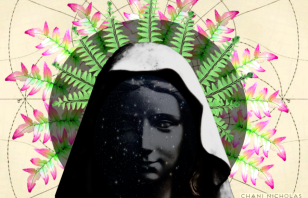
Born of the eponymously titled album, Sheezus, by Lily Allen, Sheezus Magazine is intentionally satirical in its epithet. Just as Allen is enamored and critical of the way in which women are portrayed across Western culture, as well as how they fashion themselves in the entertainment industry and mainstream media—Sheezusis too. The central function of the magazine is to feature artists, photographers, poets, and writers who want to examine the culture and literature surrounding feminism and LGBTQIA (Lesbian, Gay, Bisexual, Transgender, Queer, Intersex and Asexual) politics. Sheezus is for the DIY artist, the selfie photographer, the note-writer, the comic illustrator, the amateur philosopher, the good witch, the BAD witch, the NASTY girl, the social justice warrior, the anti-sexist, the art therapist, the male feminist, and the cyber femme. Sheezus Magazine is for SHE, HE, & US (they/them). It’s for everyone.
As a teen, I grew up in a small whitewashed town in Georgia. I was exposed to feminism through Western media, and taught to think feminism was a muck word. In college I struggled with my relationship to feminism as I was exposed to the controversial writings of Ayn Rand, Ariel Levy and Caitlin Moran. I also toiled over feminism in my romantic relationships, and with my family when I read Simone De Beauvoir’s,The Second Sex, and Eric Berkowitz’s, Sex and Punishment: Four Thousand Years of Judging Desire. Today, I still struggle with my relationship to feminism. I struggle defining it, and in turn defining myself, and I know I’m not alone.
One concept I couldn’t shake in my early twenties was how feminism’s etymology addresses women-identified individuals, and leaves other genders unacknowledged. I still question whether or not “feminist” is fundamentally an alienating word. How can we expect society to support a movement that roughly half the population feels excluded from? Feminism boasts inclusion, but does it successfully reach more than women-identified individuals?
I think it does, which is why Sheezus is meant to be accessible to all.
Taking inspiration from fellow feminist, Tavi Gevinson and her creative publication, ROOKIE Mag, this first issue of Sheezus is like an artist book. Acting as “Editor-in-Chief-tress”, designer, and fellow contributor, I’m aware of my limited perspective as a white, privileged, cis-identified female. There is a mixture of passion and vulnerability when it comes to this project, and I’m in perpetual dialogue with myself over authenticity. I question whether or not my voice is needed or appropriate, and while my voice is present in the magazine, I also want voices of those perhaps undervalued or unheard. After surveying the content, I am pleased with the diverse perspectives included in this first issue. There are multiple races, genders and cultural backgrounds established alongside my own voice. This is their space too.
This is the publication of my youth and my dreams. It acts as a tribute to a younger version of myself. A salute to an quiet girl who scattered magazine clippings, and notebook scribbles all over her bedroom floor, a girl who strived to be a writer, and the woman who became one. It’s also an offering to contemporary feminism, and the individuals throughout history who dedicated their lives to Women’s Rights and made feminism socially acceptable.
Sheezus isn’t the first feminist publication, or the last, but it is MY contribution to the movement. I’m bound to make mistakes, and maybe I’ll fail, but at least I tried, and without vulnerability there is no growth. To quote Allen, “I’m ready for all the comparisons”.
Spell ya later,
xx Zara xx
